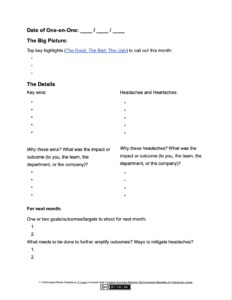A Lightweight Performance Review Template for Monthly Discussions
In my series of newsletters on preparing for your performance review, I mentioned a template you can use when talking with your manager during your one-on-one meetings (1:1s). A colleague and I have also mentioned this template in our talks on performance assessments, rewards, and recognition systems, and how to make them more supportive of Agile. Several people have requested the template, and I’m sharing it here.
I have used this template (or variations of it) in at least four companies I’ve worked in already. I use it when I meet my manager during my 1:1s, or with my direct reports when I have 1:1s with them. I do have some guidelines, so feel free to use, modify, or even add to them.
Usage Guidelines
- Use the template once each month during your 1:1 with your manager (or direct report). The idea behind the template is to get performance feedback early and often, as opposed to once a year, when HR calls on the entire company to do their performance appraisals and reviews. (And if you don’t have regular 1:1s with your manager, you should consider starting the discussion from there.)
- The idea behind the template is that it is lightweight. You don’t need to fill in every line or go into the minutia of the details. You want the right amount of discussion, and add those as highlights to capture the key points about your performance – the good, the bad, and the ugly. Most often, the good stuff – even the regular, day-to-day wins or the win of the week, aren’t brought up. People then forget these when the yearly performance review cycle comes around. And as for the bad stuff, you usually get it right away. And it can linger and follow you for ages. As Mark Anthony said in his eulogy to Caesar in Shakespeare’s play Julius Caesar, “The evil that men do lives after them. The good is oft interred with their bones.”
- Tailor the template to your needs. Modify the template depending on your context. For example, I’ve modified it to conform to an Objective and Key Results (OKRs) style at one company where I was working. You can do the same if your company uses Management by Objectives (MBOs) or something similar.
- Highlight outcomes and impacts, not outputs. People often write outputs on their performance reviews – like “refactored the architecture for our product.” Yeah – we all know you reworked and coded this, but what was the impact of that effort? Did your team get to release the product faster, positively impacting customers who were about to churn? (And mind you, this is great to bring up in your resume – recruiters and hiring managers love to see these outcomes and impacts.)
- Always move forward. The goal of performance discussions is to grow yourself – whether it’s learning new skills like becoming a team lead or using new technologies. It’s about learning from mistakes – how you and the team can mitigate issues that came up, or how you all can improve and become more Agile.
- And lastly, highlight yourself AND your team. Most performance reviews typically highlight the individual. Agile emphasizes team collaboration. Don’t just talk about yourself. Talk about how you and your team get together or do things together to amplify successful outcomes – not just for you but for the team and the company.
When you do these things, you will end up with 12 templates filled out – one for each month. And guess what happens when HR sends out that email informing everyone about the upcoming performance review cycle? You’ll be very prepared to fill out your performance assessment.
Having these monthly filled-out documents, joyously made it easy for me to fill out my assessment (or my direct reports’ assessments). I didn’t have to stress out remembering what I had accomplished in the past 12 months. I mostly ended up copying and pasting what I had written, with maybe a little bit of wordsmithing, to fit the assessment outlines provided by HR.
I do hope you find value in this template. I would love to know how you modified it to fit your context. I’d love your feedback on your experience using it – the good, the bad, and the ugly of it. I’d love to hear from you.
